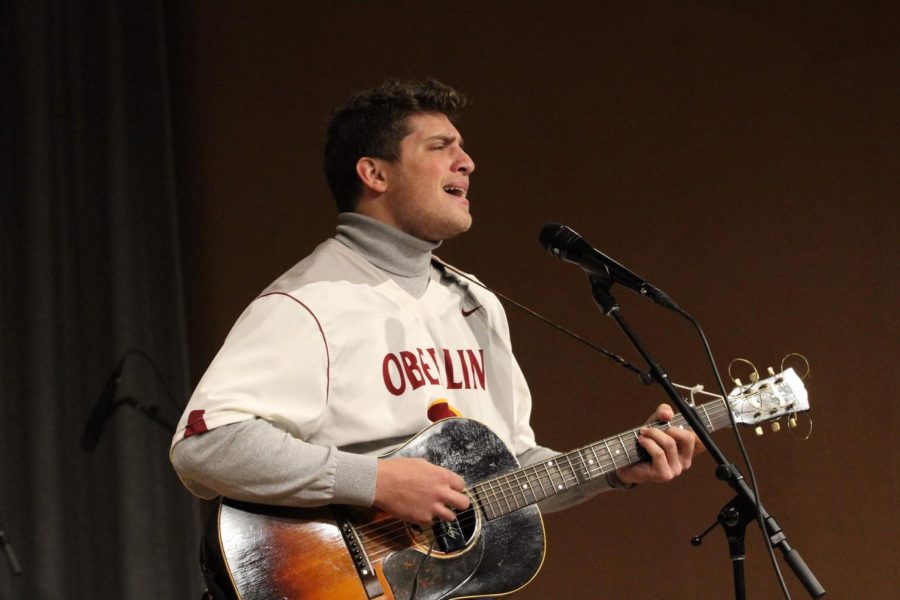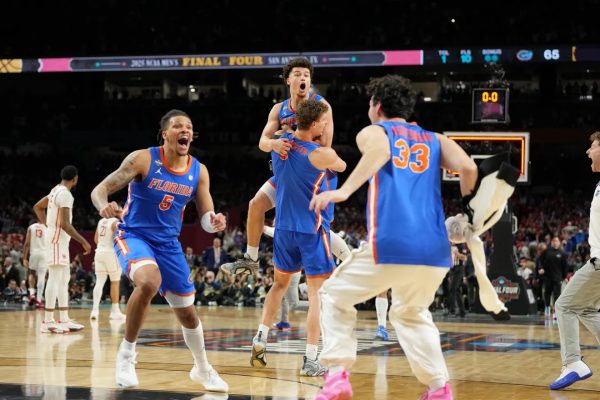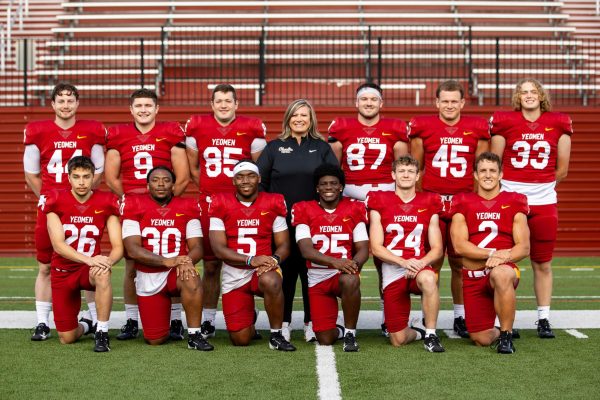Student-Athletes Shine at Sharing Stages
Photo courtesy of Erik Andrews
College senior and men’s lacrosse captain Elie Small
Saturday night in the William and Helen Birenbaum Innovation and Performance Space, I realized what I love most about Oberlin: its tendency to foster creativity and collaboration, and the way people can express their diverse backgrounds, interests, and talents. I am regularly in awe of and inspired by the bright and energetic students on campus.
Last weekend, students of the College and the Conservatory, athletes and non-athletes, parents, and administrators came together to celebrate some of Oberlin’s most musically inclined athletes at the fourth annual Sharing Stages.
A number of student-athletes took the stage, including Conservatory first-year and baseball player Ian Ashby, double-degree sophomore and distance runner Claudia Hinsdale, Conservatory sophomore and sprinter Jacob Britton, College junior and former tennis player Lena Rich, and College senior and men’s lacrosse captain Elie Small.
Music and athletics have more in common than one might think. Athletics molds participants into leaders and insists that only those who work hard and dedicate themselves to their craft will succeed, and the same holds true in music.
A baseball pitcher must be in total control of their body; if their arm motion or stride is centimeters off, the pitch won’t move the way it’s meant to or cross the plate where it should. The same rules apply to playing an instrument.
Likewise, running is all about rhythm. Your breathing patterns must be in harmony with the pumping of your arms and the lifting of your knees, or else you can’t possibly run your best. Athletes and musicians learn how to master repetition, anticipation, and their own bodies in relation to others.
“Whether it’s trying to find the right chord or lyric to finish a song, or working to improve my shot or skills [in lacrosse], music and lacrosse both require working hard and persevering,” Small said. “Music has taught me [that] you need to put your hours in and practice to grow and even maintain your skills. Lacrosse has taught me similar lessons. Your performance on the field is a result of the reps you put in on the field and in the weight room.”
Small became interested in music after watching his older brother play guitar, and he began playing and writing songs at age six. He also plays the piano, drums, and mandolin.
“Music definitely influenced my decision to come to Oberlin,” Small said. “I really wanted to be in an environment surrounded by talented musicians, and to have the opportunity to take music courses in the Conservatory.”
The singer-songwriter has produced five albums. His latest, Dancing in the Fire, came out in September 2016 and features the song that Small performed Saturday, “Lego Girl.”
“The inspiration behind the song is that I believe too many people live their lives by a set of prewritten ‘Lego’ directions, whether it’s waiting a certain amount of time before texting a guy back after a date, conforming to musical and fashion trends, or trying to build the perfect life on social media,” Small said.
Hinsdale, a Technology in Music and Related Arts major in the Conservatory and Environmental Studies major in the College, also performed a piece she created herself called “Phase Canon.”
As a TIMARA major, Hinsdale has developed a wide set of skills and the ability to follow her own artistic trajectory, which can include acoustic and electronic/electroacoustic composition, installation, instrument building, live performance, mixed media, and a multitude of other practices.
The piece she performed with Conservatory first-year Noah Hellman, who played alto saxophone, and Conservatory sophomore Jeremy McCabe, who played percussion, was based on an interface she made in a program called Max. She drew inspiration from a 36-voice Renaissance piece, and originally wrote her piece with live vocal performance in mind.
“The piece was in some ways a structured improvisation,” Hinsdale said. “I planned out a trajectory I wanted the piece to follow, but trusted the musicians to use their intuition and let it develop organically.”
After Oberlin, Hinsdale said she wants to do research that will integrate both of her degrees and weave her interests together.
“That could be in the form of acoustic ecological research or making music based on biological patterns, data, and phenomenon,” she said. “I also think ecological engineering is really cool, and I’d love to connect that to the engineering of spaces in which music is performed.”
Rich, who spent the summer touring nationally and playing country music, performed the song “Guidance” from her album Something in Between, which is available on all online platforms. She shared the stage with Ashby, who plays the bass in the Conservatory and is the son of Associate Professor of Jazz Arranging and five-time Grammy Award-winning producer Jay Ashby. Ashby also performed alongside Britton, who played the vibraphone.
Perhaps students attend Oberlin because it allows them to be everything they want to be. Hinsdale doesn’t have to choose between running, music, and biology. Oberlin gives her the resources and opportunities to mix all three together to create a unique product. Small doesn’t have to miss out on being captain of a varsity sports team or a member of Student Senate, because his college experience has taught him how to balance all of his interests without becoming overwhelmed.
As my own time left here dwindles down, I hope to make it to as many concerts, performances, and athletic contests as I can, and to never stop appreciating the beautiful collisions that only occur at a place like Oberlin.






